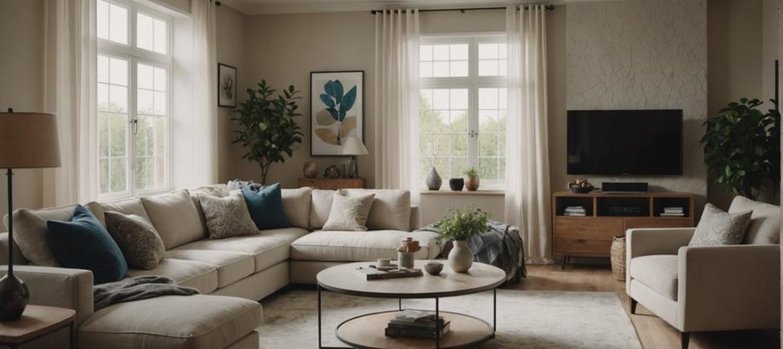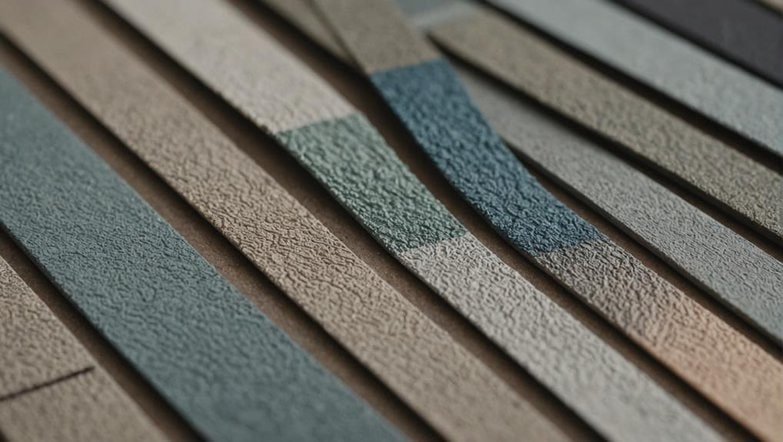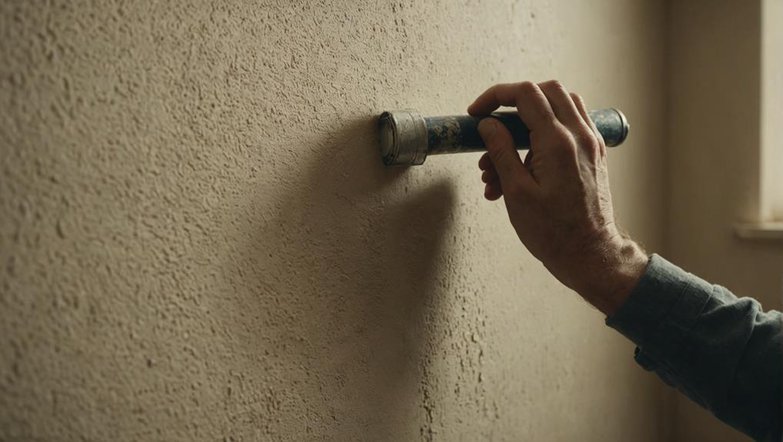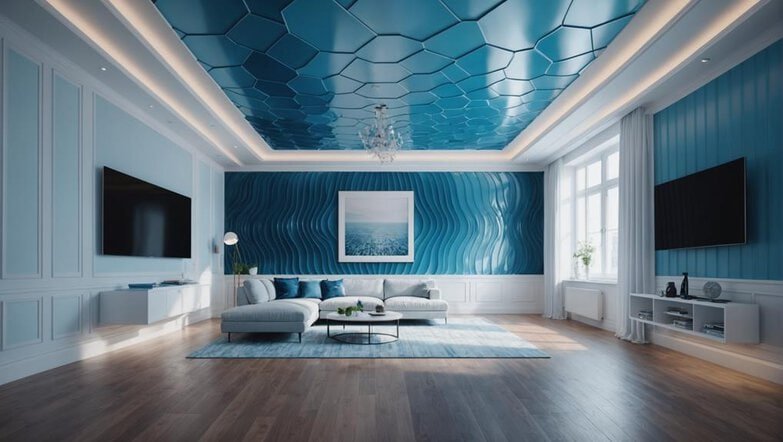Best Textured Paints for Interior Walls

To choose the best textured paints for interior walls, consider options like stucco, faux plaster, sponge technique, metallic sheen, and sand texture finishes.
Brands such as Benjamin Moore, Sherwin-Williams, and Behr are highly recommended for their quality and variety. Textured paints not only hide imperfections but also add depth and interest to any room. They’re straightforward to apply, especially with the right tools and proper wall preparation.
Opt for durable, eco-friendly products that withstand wear and tear. For small spaces, lighter shades with semi-gloss finishes can make rooms feel larger. Investigate these tips to improve your interiors effectively.
Key Takeaways
- Benjamin Moore: Renowned for high-quality textured paint options and durable finishes.
- Sherwin-Williams: Offers a diverse range of textured techniques and vibrant colors.
- Behr: Provides various textured paint colors suitable for different interior styles.
- Long-lasting Finishes: Maintains appearance despite everyday wear and tear for long-term durability.
Types of Textured Paint Finishes
When choosing a textured paint, you’ll encounter a range of finishes, from subtle, sand-like textures to more dramatic, raised patterns that add depth and visual interest to your walls.
One popular option is the stucco finish, which mimics the look of traditional stucco with its raised, irregular texture. You can also opt for a faux plaster finish, which replicates the smooth, creamy look of plaster without the need for actual plastering. For a more unique look, try the sponge technique, which involves applying paint with a sponge to create a textured, irregular pattern.
If you want to add a touch of glamour to your walls, consider a metallic sheen finish, which gives your walls a subtle shimmer. Alternatively, you can opt for a sand texture finish, which adds a subtle, grainy texture to your walls.
Whatever finish you choose, make sure it complements the style and decor of your room. With so many options available, you’re sure to find the perfect textured paint finish to improve the look and feel of your space.
Benefits of Using Textured Paints
By selecting a textured paint finish that suits your style, you not only improve the aesthetic of your space but also release a host of benefits that can transform the look, feel, and functionality of your interior walls.
You’re leveraging color psychology to influence the ambiance of your rooms, creating a cozy atmosphere or energizing the space.
Textured paints also come with practical maintenance considerations, as they can hide minor imperfections and scuffs, making upkeep a breeze.
When applying textured paint, you can investigate different application techniques, from DIY-friendly options to more complex, professional methods.
While textured paints may require a slightly higher upfront cost, a cost analysis reveals long-term benefits, such as increased durability and reduced repair needs.
By incorporating textured paints, you’re also tapping into the latest design trends, which emphasize depth and visual interest.
With textured paints, you’re not just coating your walls – you’re creating a statement piece that adds character and personality to your space.
Best Brands for Textured Paints

Among the numerous options on the market, several top brands stand out for their high-quality textured paints that can improve the look and feel of your interior walls. When searching for the best textured brands, you’ll want to evaluate factors such as durability, color selection, and finish. Reading textured paint reviews from other customers can also provide valuable insights into a brand’s performance.
Some top brands for textured paints include Benjamin Moore, Sherwin-Williams, and Behr. These brands offer a range of textured paint techniques, from subtle, fine finishes to more dramatic, raised patterns. You can also choose from a variety of textured paint colors to match your unique style and decor.
Staying on top of textured paint trends can also help you make an informed decision. Currently, metallic and glitter finishes are popular for adding a touch of glamour to walls. Whatever your preference, be sure to select a brand that offers high-quality, long-lasting results.
Most Durable Textured Paint Options
Evaluating the durability of textured paints is vital to guarantee your interior walls withstand the wear and tear of daily life, so let’s investigate the most durable options. You want long-lasting finishes that maintain their appearance over time, despite occasional scratches or scuffs. Look for weather-resistant options that can handle changes in temperature and humidity without compromising their texture or color.
When it comes to maintenance, choose textured paints that are easy to clean and repair. Consider eco-friendly choices made from sustainable materials that minimize environmental impact. These eco-friendly options often have low VOCs (volatile organic compounds), which contribute to a healthier indoor environment.
To extend the life of your textured paint, follow simple maintenance tips like regular dusting and gentle cleaning with a soft cloth. This will help preserve the color retention and prevent dirt buildup.
Don’t forget to touch up any damaged areas promptly to prevent them from becoming larger issues. By choosing a durable textured paint and following basic maintenance, you can enjoy beautiful, long-lasting finishes that add depth and character to your interior walls. This way, your walls will look great for years to come.
Easiest Textured Paints to Apply

Choosing the easiest textured paints to apply can save you time and stress, allowing you to achieve professional-looking results even if you’re a DIY beginner.
Regarding applying textured paint, you’ve got several options, including spray application techniques and roller texture methods. For DIY texture projects, it’s fundamental to choose a paint that’s specifically designed for your chosen application method.
To guarantee a smooth application process, make certain you’ve got the right texture paint tools for the job. A high-quality roller or spray gun can make all the difference in achieving a professional-looking finish.
Surface preparation is also vital, so don’t skimp on the prep work. Clean and prime your walls before applying the textured paint, and make certain to follow the manufacturer’s instructions for application and drying times.
Textured Paints for Small Spaces
When working with small spaces, you’ll want to contemplate textured paints that create a sense of depth and visual interest without overwhelming the room. By employing the right textured wall techniques, you can create small space illusions that make the area feel more expansive.
One effective strategy is to use color contrast, pairing light and dark shades to create a sense of layering. Furthermore, consider the light reflection effects of your chosen paint; a semi-gloss finish can help bounce light around the room, making it feel more spacious.
To incorporate visual interest without overwhelming the space, try pattern mixing tips like combining a textured paint with a smooth finish. This will create a subtle, nuanced look that introduces depth without overwhelming the senses.
When selecting a textured paint, choose one with a subtle pattern that won’t compete with other design elements in the room. By carefully considering these factors, you can use textured paint to improve your small space without making it feel cramped or cluttered.
Creative Ways to Use Texture

You can take your walls to the next level by experimenting with creative texture applications, from subtle, tone-on-tone effects to statement-making, geometric patterns.
Add visual interest with textured wall art, created using materials like molding paste or heavy gel medium. For a more intricate design, try creative stenciling techniques, layering paint styles to achieve a unique, multi-dimensional look. Draw inspiration from faux finishes, using techniques like ragging or sponging to create soft, mottled textures.
For a bold, eye-catching effect, experiment with unique pattern ideas, combining texture and color to create a one-of-a-kind design. Consider layering a textured paint over a bold, contrasting color, or using a stencil to add a textured pattern to a plain background.
You can also use texture to create a focal point in a room, drawing attention to a particular area or feature. By experimenting with creative texture applications, you can add depth, interest, and personality to your walls, taking your space from ordinary to extraordinary.
With a little practice and patience, you can achieve professional-looking results and reveal the full potential of textured paint.
Frequently Asked Questions
Can Textured Paint Be Used on Ceilings as Well as Walls?
You can definitely use textured paint on ceilings, but consider the specific textured paint applications and ceiling texture options to guarantee paint finish compatibility, and don’t forget aesthetic considerations and texture maintenance tips for a polished look.
Is It Possible to Paint Over Existing Textured Paint Finishes?
Yes, you can paint over existing textured paint finishes. Guarantee proper surface preparation, choose the right color selection, and maintain texture consistency. Use appropriate painting techniques and application methods to achieve a smooth, even result.
Are Textured Paints Suitable for Use in High-Humidity Areas?
Yes, textured paints can work in high-humidity areas. Choose moisture-resistant options and investigate different application techniques. Consider finish options and color choices that suit your space. Regular maintenance tips will help keep the paint looking fresh.
Can Textured Paints Be Used on Surfaces Other Than Drywall?
Yes, you can use textured paint types on surfaces other than drywall. Just guarantee proper surface preparation, choose the right application techniques, and consider color selection and maintenance tips for the best results.
How Do I Repair Damaged or Uneven Textured Paint Finishes?
To repair damaged or uneven textured paint finishes, initially clean the area. Use texture application techniques to match the existing pattern. Smooth out uneven surface solutions where needed. Follow up with paint texture matching and wall maintenance tips.
